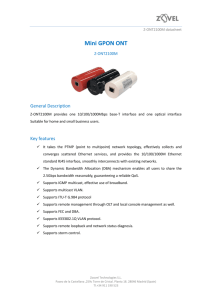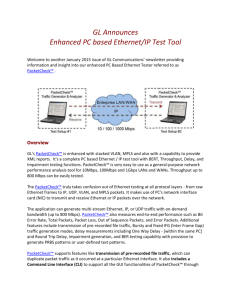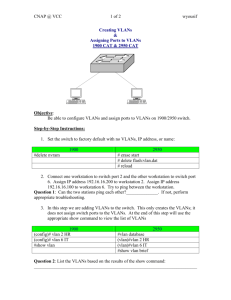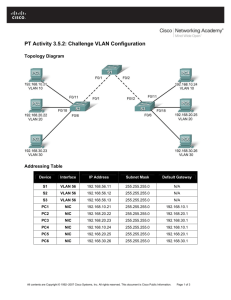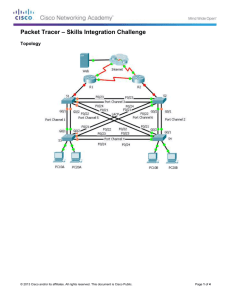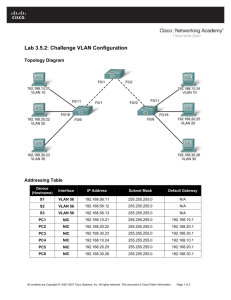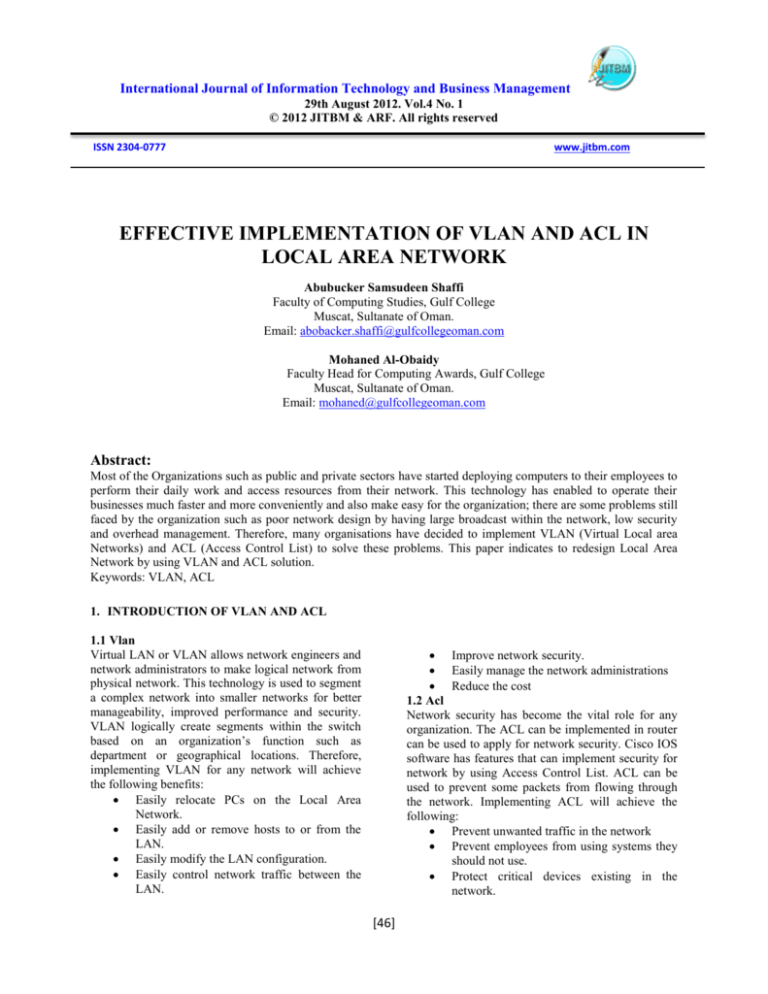
International Journal of Information Technology and Business Management
29th August 2012. Vol.4 No. 1
© 2012 JITBM & ARF. All rights reserved
ISSN 2304-0777
www.jitbm.com
EFFECTIVE IMPLEMENTATION OF VLAN AND ACL IN
LOCAL AREA NETWORK
Abubucker Samsudeen Shaffi
Faculty of Computing Studies, Gulf College
Muscat, Sultanate of Oman.
Email: abobacker.shaffi@gulfcollegeoman.com
Mohaned Al-Obaidy
Faculty Head for Computing Awards, Gulf College
Muscat, Sultanate of Oman.
Email: mohaned@gulfcollegeoman.com
Abstract:
Most of the Organizations such as public and private sectors have started deploying computers to their employees to
perform their daily work and access resources from their network. This technology has enabled to operate their
businesses much faster and more conveniently and also make easy for the organization; there are some problems still
faced by the organization such as poor network design by having large broadcast within the network, low security
and overhead management. Therefore, many organisations have decided to implement VLAN (Virtual Local area
Networks) and ACL (Access Control List) to solve these problems. This paper indicates to redesign Local Area
Network by using VLAN and ACL solution.
Keywords: VLAN, ACL
1. INTRODUCTION OF VLAN AND ACL
1.1 Vlan
Virtual LAN or VLAN allows network engineers and
network administrators to make logical network from
physical network. This technology is used to segment
a complex network into smaller networks for better
manageability, improved performance and security.
VLAN logically create segments within the switch
based on an organization’s function such as
department or geographical locations. Therefore,
implementing VLAN for any network will achieve
the following benefits:
Easily relocate PCs on the Local Area
Network.
Easily add or remove hosts to or from the
LAN.
Easily modify the LAN configuration.
Easily control network traffic between the
LAN.
Improve network security.
Easily manage the network administrations
Reduce the cost
1.2 Acl
Network security has become the vital role for any
organization. The ACL can be implemented in router
can be used to apply for network security. Cisco IOS
software has features that can implement security for
network by using Access Control List. ACL can be
used to prevent some packets from flowing through
the network. Implementing ACL will achieve the
following:
Prevent unwanted traffic in the network
Prevent employees from using systems they
should not use.
Protect critical devices existing in the
network.
[46]
International Journal of Information Technology and Business Management
29th August 2012. Vol.4 No. 1
© 2012 JITBM & ARF. All rights reserved
ISSN 2304-0777
www.jitbm.com
This organization has started connected all branches
through MPLS technology provided by ISP (Internet
Service Provider). There is a problem with existing
design. All these problems can be solved by the
implementation of VLAN and ACL in the
organization networks.
ACL provides access or denied services.
2. SCENARIO
The organization has many departments such as
Human Resource, IT department and Finance. Many
organizations have some problems in the existing
design. For example if any computer request for
particular service, the request will be sent to the
entire LAN until it gets an acknowledgment from
the receiver. Therefore, this network will have a
heavy broadcast. Besides, the organisation does not
have a switch for each department to reduce
broadcasting and to increase the number of
broadcasts, because a switch has one broadcast and
many collisions. If the two employee attempts send
data at the same time, a collision will occur and all
the transmitted data will be lost. Once the collision
has occurred it will continue to be propagated
throughout the network by hubs and repeaters.
Retransmitting the losing data, it leads a significant
wastage of time and resources. Also, the current
setup does not filter unwanted traffic travelling
across the network to main hosts. So this will let the
most important host vulnerable to any attacks
internally. Poor design and large broadcast domain
in the existing network will affect network
performance and security of the network. Some time
it is very difficult to isolate the problems in the
networks. It is very difficult to manage the whole
networks by the Network administrator. The Figure
1 indicates the existing organization infrastructure.
3.
FUNCTIONAL REQUIREMENTS
The type of functionality required for the
organization is:
Network
engineer
should
erase
any
configuration stored in the router before setting
up the new network design.
Network engineer should choose class B IP
address to this network for further growth.
Network engineer should enter strong password
for the network devices. Also, it should be
encrypted.
Each device configured such as router and
switch should be backed up and stored in a
secure place.
VLAN encapsulation should be 802.1q
Network admin should apply Extended Access
Control List.
Network engineer or administrator should
create sub interfaces for each VLAN in the
router.
Assign each port in the switch to its related
VLAN.
4. IMPLEMENTATION OF VLAN:
Current Network infrastructure
Muscat Head Office
Branch_1
IT Department
Sw
itc
h
Sw
itc
h
The VLAN will help to solve this problem.The
requirement for new design is Cisco layer 2
switches and layer three devices to carry out the new
setup. The organization need to purchase the
managed switch which supports the VLAN
interface. VLAN should be membership by using
port number. All ports or interfaces in the switch are
considered in one VLAN and one broadcast
domain.The solution for this problem is by
configuring VLAN in the switches and to put some
ports into one broadcast domain and some into
another broadcast within the same switch. So, this
will segment hosts into smaller LAN to reduce
overhead caused to each device. Therefore, Network
Sw
itc
h
Router
Database
Server
OmanTel _MPLS Cloud
Branch_2
Sw
itc
h
File Server
Printer
Server
Sw
itc
h
Application
Server
Human Resources
Finance
Branch_3
Sw
itc
h
Figure 1: Design for existing organization
infrastructure
[47]
International Journal of Information Technology and Business Management
29th August 2012. Vol.4 No. 1
© 2012 JITBM & ARF. All rights reserved
ISSN 2304-0777
www.jitbm.com
Administrator has created VLAN for each
department then enabled the communication
between them by using layer three devices. Access
Control List has been used to enforce better security
and to filter unwanted packets.
can enable communication between VLANs with
different vendor of switches.
5. IMPLEMENTATION OF ACL
4.1 Operation of VLAN
Access Control List Operation
VLANs Operation
VLAN 1
VLAN 1
VLAN 1
VLAN 2
VLAN 3
Packet permitted
Host A
router
Packet Denied
VLAN 2
VLAN 2
VLAN 3
VLAN 3
Host B
Network Management Station
Human
resources
Network
Research &
development
Network
Figure 3: Access Control List Operations
Figure 2: VLANs Operation
The Network Administrator implements the ACL in
the router to give the permission to access or denied
permission for the employee in the organization. The
Access control list is a technique used to prevent the
unwanted the network traffic through the control of
packets that are sent or blocked at router interface.
The router test every packet accordance with the
criteria set within ACLs. Then it makes the decision
whether to forward or drop the packet based on IP
address and port. The network administrator can use
ACL to restrict contents of routing update and to
provide security for the network by filtering
unwanted traffic. For example, you can permit e-mail
traffic to be routed, but at the same time block all
Telnet traffic. Network administrator should use
access lists to provide a basic level of security for
accessing their network.
VLAN can be implemented in each switch. It acts as
one broadcast domain. Switch ports could be
assigned to different VLAN. Therefore, any ports
assigned to the same VLAN share the same broadcast
domain. Each switch can carry more than one VLAN
as shown in Figure 2, there are two switches, and
each one handles several VLAN. Each VLAN can
assign to each department according to the
organization requirements shown below.
Table 1: Assigning switch port to VLANs
Switch Port
VLAN
Departments
1
VLAN-1
Human resource
2
VLAN-2
IT
3
VALN-3
Finance
To enable communication between VLAN, trucking
Protocol is configured in the link between switches. It
will use 802.1q trunking protocol, because the
majority of respondents used it for their network
configuration. Also, 802.1q is IEEE standard, so we
6. CONFIGURATION OF ROUTER, SWITCH
AND HOST
6.1 Router configuration For this setup, we will
create sub-interfaces for each VLAN needed for each
[48]
International Journal of Information Technology and Business Management
29th August 2012. Vol.4 No. 1
© 2012 JITBM & ARF. All rights reserved
ISSN 2304-0777
www.jitbm.com
section. These sub- interfaces that will be created in
layer three devices will enable communication
between different VLANs. Besides, it will restrict
each section to specific IP address scheme. Also,
Access Control List will be implemented in the layer
three devices to restrict specific hosts from particular
action such as telnet.
destination host which to
be tested.
Expected Result
This will show the
expected result before the
test (Pass or fail).
Actual result
This will display the
actual result after the test
has been completed. For
example, Access Control
List functions as design
without error.
6.3 Host configuration For these devices, assigning
IP address will be assigned for each host according to
its related VLAN. Also, the default gateway will be
the IP address assigned for the sub-interface in the
layer three devices.
Technique
This will show the test
how will be done. For
example, this test done by
sending denied packet to
specific network.
7. TESTING
Responsibilities
Here will show the test
done by whom.
Schedules
It will display the date of
the test.
Comment
It will show if there is a
special consideration.
6.2 Switch configuration The setup needed for this
device is creating VLANs and assigning each port to
its related VLAN. Also, security will be implemented
for layer two devices by enabling secret password for
switch, console and telnet session.
7.1 Scope
The type of testing that will be addressed by plan to
ensure the communication between different VLAN
through layer three devices. Also, to ensure that each
access control list in the routers functioning correctly.
7.2. Network administrator Procedures
Network administrator should make sure that every
testing phase success. Otherwise, if there is any
change, he/she must update the configuration of the
item as well as user manual.
7.4 Testing Network Devices
7.4.1 Host to host connection
7.3. Test Strategy
The test document should include the following
details of the test strategies, to make the test more
efficiently.
Test Strategy
Descriptions
Purpose for this level of
test
This will show the test
target
to
meet
organizations objective.
For example: Ensure ACL
function properly and
without mistakes.
Items to be tested
This will determine the
source host and the
We going to test connectivity from host connected to
switch and host connected in different switch in the
same VLAN ID by using ping command. As well as
testing the communication between host and the
router interface. Also, this project will test the
communication between hosts in the same VLAN
switch.
7.4.2 Access Control List testing
We going to test ACLs by using Run program in
workstation when we want to test access-list from
workstation to other destination. On the other hand,
when we want to test it from each router to other
destination we use Hyper Terminal software.
[49]
International Journal of Information Technology and Business Management
29th August 2012. Vol.4 No. 1
© 2012 JITBM & ARF. All rights reserved
ISSN 2304-0777
www.jitbm.com
7.4.3 Remote Login Testing
1
Test Name
VLAN to Router sub-
The Telnet service provides a remote login
capability. This lets a network engineer on one host
or computer log into another host and acts as if
he/she is directly in front of the remote router or
switch. The connection can be anywhere on the local
network. Telnet uses TCP protocol to maintain a
connection between two devices. Telnet uses port
number 23.
2
Date
interface
26/06/2012
3
Test Target
To ensure that there is
communication
between VLAN 2 and
its related sub-interface
in the router.
4
Source IP
180.182.2.11
5
Destination IP
180.182.2.1
6
Technique
By sending Packet
from Packet Tracer or
by using Ping
functionality
7
Expected result
Pass
Actual Result
Successful after fixing
the problem and now
there is communication
between VLAN 2 and
it is related subinterface.
9
Comment
This project has trace
what was the problem
and find out that on the
router
sub-interface
after encapsulation type
we must put the same
VLAN
ID
(encapsulation dot1q
2). So the problem
fixed and the result
successful as it was
planned.
10
Done By
Administrator
7.5 Testing Results
7.5.1 Host to Host Testing
Network Design Using VLAN and ACL
Test Name
Host to Host
Date
25/06/2012
Test Target
To ensure that there is
communication between hosts in
the VLAN 2
Source IP
180.182.2.11
Destination IP
180.182.2.12
Technique
By sending Packet from Packet
Tracer or by using Ping
functionality
Expected result
Pass
Actual Result
Successful. There is a
communication between host in
the VLAN 2
8
Comment
Done By
Administrator
7.5.2 VLAN to Router
Network Design Using VLAN and ACL
7.5.3 Testing Access Control List
[50]
International Journal of Information Technology and Business Management
29th August 2012. Vol.4 No. 1
© 2012 JITBM & ARF. All rights reserved
ISSN 2304-0777
www.jitbm.com
Network Design Using VLAN and ACL
2
Date
26/06/2012
To ensure that there is
communication
between
router02 LAN and IT
department VLAN 2, because
all servers existing in this
VLAN
1
Test Name
Checking Access Control List
2
Date
Functionality
26/06/2012
3
Test Target
Test Target
To ensure that all hosts in
VLAN 3 can not establish
Telnet session to router subinterfaces.
4
Source IP
3
4
Source IP
180.183.3.11
180.182.2.1
180.183.3.12
5
Destination
180.182.2.1
IP
180.183.3.1
185.185.5.11
5
Destination IP
180.182.2.11
180.182.2.12
180.182.2.13
180.184.4.1
6
7
Technique
Expected
result
8
9
10
Actual
Result
Comment
Done By
By sending Packet from Packet
Tracer or by using Telnet
session.
By sending Packet from
Packet Tracer or by using
Ping Functionality.
7
Expected
Successful
8
Actual Result
Successful,
there
is
communication
between
router02 and VLAN 2
9
Comment
To enable routing, we should
maintain ip route command in
both router01 and router02.
10
Done By
Administrator
Successful , Telnet session can
be established
This project has trace what was
the problem and it find out that
Access list after it created
should be applied on the router
to its related logical interface.
So the problem fixed and now
telnet session can not establish.
8. NETWORK DESIGN FOR VLAN & ACL
Administrator
Network Design Using VLAN and ACL
Test Name
Technique
result
Failed, Telnet session can not
establish
7.5.4 Testing Routing Functionality
1
6
Routing Functionality
[51]
International Journal of Information Technology and Business Management
29th August 2012. Vol.4 No. 1
© 2012 JITBM & ARF. All rights reserved
ISSN 2304-0777
www.jitbm.com
Network Design Using VLAN and ACLs
Human resources VLAN 4
Default Gateway: 180.184.4.1
Sohar Site
IP: 180.184.4.11
Sw
itc
h
IP: 180.184.4.12
Muscat Site
Sw
itc
h
IP: 180.184.4.13
S0/0/0
ip address 192.168.1.1
F0/0
S0/0/0
ip address 192.168.1.2
Router
F0/0
IP address 185.185.5.1
Finance VLAN 3
Default Gateway: 180.183.3.1
IP: 180.183.3.11
Sw
itc
h
VLAN 4
IP: 180.183.3.12
IT Department VLAN 2
Default Gateway: 180.182.2.1
Access Control List
Implemented in this
interface to block
Telnet coming from
VLAN 4 and VLAN 3
REFERENCES
Sw
itc
h
Three Sub interface:
IP: 180.184.4.14
Access Control List
Implemented in this
interface to block
Telnet coming from
this LAN
To filter unwanted packets by using ACL
such as Telnet and Ping.
To have more than one broadcast within the
same switch by creating more than one
VLAN.
To have an overview of how to troubleshoot
VLAN configuration.
To reduce the cost which eliminate the need
for expensive router.
# int f0/0.1
ip address 180.182.2.1
[1]. Computer Networks and Internets, 3rd Edition
Comer, D. E. and Droms, R. E.Prentice Hall
2003
# int f0/0.2
ip address 180.183.3.1
# int f0/0.4
ip address 180.184.4.1
IP: 180.182.2.11
Sw
itc
h
IP: 180.182.2.12
IP: 180.182.2.13
[2]. Computer Networks, 4th EditionTanenbaum, A.
S.Prentice Hall 2004
IP: 185.185.5.11
IP: 185.185.5.13
IP: 185.185.5.12
[3]. CCNA Voice : Study Guide Exam 640-460 :
Froehlich, Andrew, Sybex
[4]. Computer and Network Technology :
Proceedings of the International Conference On
ICCNT 2009: Zhou, Jianhong Mahadevan,
Venkatesh, World Scientific Publishing Co.
Figure 4: Network design Using VLAN and ACL
The above diagram clearly indicates the how the
organizations are effectively implemented the VLAN
in switch and ACL in router and how does it
operates.
[5].
Computer
Network,
New Age International
CONCLUSION
S.S.
[6]. CCNA : Cisco Certified Network Associate
Review Guide (640-802): Lammle, Todd, Sybex
This paper is more helpful to the organization for the
effective implements of VLAN and to enhance
network security by keeping devices that operates
with sensitive information on a separate VLAN. The
organizations will get the following benefits:
Shinde,
[7]. Odom, W 2008, CCNA Official Exam
Certification Library, Third Edition, Cisco Press,
USA
[8]. CCNA Security Study Guide : Exam 640-553 ,
Boyles, Tim, Sybex
To improve manageability that groups users
by section instead of by physical section.
[52]



